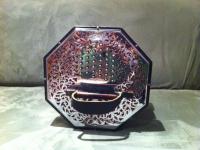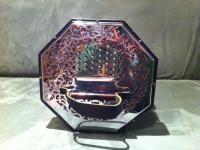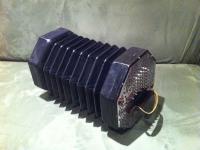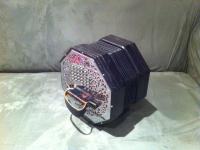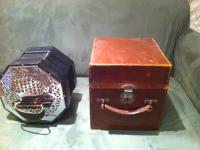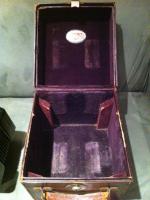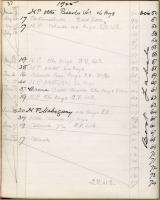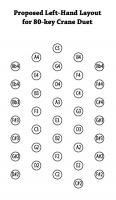
Josh Birch
Members-
Posts
26 -
Joined
-
Last visited
Everything posted by Josh Birch
-
Hi, folks, After a whole lot of years I seem to be on the verge of going over to the dark side and switching from English to Anglo. I'm trading in my Lachenal for a C/G Céilí, and now all that's left is the button layout, which is where this post comes in... I also play B/C/C# accordion so I'm familiar with the principles involved in bisonoric boxes, but I've only been working on Anglo concertina for about six months and I feel like I ought to get some other people's opinions before I go forward with a custom layout. I've attached a keyboard map of what I'm working on now, with modified notes in blue; here's the general idea: I play only fiddle tunes with occasional chordal embellishment -- no full chordal backup -- in keys from Bb through to E and related minors. I also only play in the fiddle range, so the vast majority of the time I'm between G3 and B5, only occasionally going up to E6 for a handful of tunes. My aim is to keep to the Wheatstone layout as much as possible for accessibility with other people's instruments, while making a few modifications to give me reversals that I'd like or improve the ergonomics in particular keys. I play a lot of Irish music, and I've heard a lot of people say that Irish players generally prefer Jeffries. I do have a substantial repertoire in Bb, F and C from other traditions that I'd like to carry over, though, and for flat keys in particular I just really feel like I need the pull D#5 on the first button and the A5/G5 reversal on the second button. The thing that makes me a little nervous about my modifications is that I seem to be doing some things that I've never heard anyone else talk about, which might be because they're actually bad ideas. If anyone has the patience to read through all this, I'd love to get your feedback on what I'm doing here and hear whether you think it makes sense or whether I'm making mistakes you could set me straight on! LEFT HAND ACCIDENTAL ROW * I've replaced the first button with G#3/C4. I don't really need notes lower than G3, as I mentioned, so I'm opting here for a G# that I do need in some melodies, and a pull C to use with an F chord. C ROW * I don't quite know what to do with the push note on the first button of the middle row. The low C3 is totally useless for me; in the end the best thing I could think of was E3 to give me the potential to go a little lower when playing in octaves, but if anyone has a better idea I'd definitely love to hear it. RIGHT HAND ACCIDENTAL ROW * It seems like just about every tune I play in Bb or F features a jump between F5 and Bb5, so I've moved the Bb from the third to the fourth button so I don’t have to use the same finger for both notes. * Moving the Bb5 opened up a space to fill for the reversal of G#5. As weird as this is, I can't seem to get away from wanting another G#5 here for ornaments with F#5 which would otherwise be pretty ugly, and easier phrasings in the key of A in general. I've definitely never ever heard of someone opting for a unisonoric G# key on Anglo, though, so...? * I haven't figured out what to do with the fifth button. I don't think I'll ever need a D#6 for anything, so I'm looking at reversals. If there's space for the reeds, a pull C#4 could be useful for the occasional F# chord; I could also imagine a push F#5 being very useful, though obviously I can't fit those on the same button. It's such an awkward button for me to reach that I don't really want to put anything too important there, but it's still precious real estate that I feel like I should do something useful with. G ROW * I don't have a use for the high notes past the third button. For the fourth I've put the Jeffries-inspired D#5/C#5 reversal that I'm hoping will give me some of the best of both worlds. It's a perfectly useful position that otherwise would almost never get used so I feel pretty happy with it, except again for the fact that I've never heard of anyone else doing something like this. * For the fifth button I've put a push F#4 for occasional chording or maybe smoothing out phrasing, and E4 on the pull also for chording — particularly for an A chord when I don't have enough air to use the RH push notes -- or helping me out of jams in Em. I think that's it! If anyone has any thoughts at all on all of this, positive or negative, I would love to hear them. Thanks so much, Josh
-
Practicalities With A 64-Key English
Josh Birch replied to Josh Birch's topic in General Concertina Discussion
Well, after realizing that Juliette Daum is actually playing what appears to be very same model of tenor-extended treble in some of her recordings and videos, I caved in and asked to be shipped both on approval. I'll post my observations on the 64-key business once it arrives... Somehow I've managed never to have played a Lachenal before so I'm not sure exactly what to expect there. The seller reports the action is smooth and quiet. ceemonster, I'll PM you about the Geordie... -
Practicalities With A 64-Key English
Josh Birch replied to Josh Birch's topic in General Concertina Discussion
Thanks so much to everyone for your thoughts and advice! It is indeed the tenor to extended treble range (C3 to G7) on this instrument. I can't really imagine needing (or wanting to hear, honestly) the notes higher than C7, but I know that theoretically flautists and violinists are sometimes asked to play those notes. On the other hand, I would love to be able to go down into the lowest clarinet range and octave-up cello, etc. Jim, I think I'll take your advice. I'm sure this instrument is more expensive than just a tenor-treble would be, and I really don't need any more range than that. It's a wrench, because it's a particularly fine example of its species, but I think I'll let it go and approach the issue of greater range later on. There's a lot to be said for domestic harmony, not to mention staying out of debtor's prison. Thanks again to all. -
As is probably obvious from my flurry of posts recently, I'm in the market for a new EC and I'm down to choosing between a Lachenal New Model treble and a 64-key Aeola extended tenor-treble in fantastic condition that's almost twice the price. In fact, the Aeola is really rather more than I can reasonably afford, but at the risk of seriously upsetting my wife I could probably make it work. Theoretically, all that range, in a package only barely larger and heavier than a Jackie, seems like a great idea. I could play clarinet and cello repertoire, in addition to flute and violin! No more worrying about range ever again! Real bass notes! I know, though, that sometimes ideas look fantastic on paper but run into trouble when translated into reality; I can't help noticing that there aren't a whole lot of people out there playing 64-key instruments. For those who have a 64-key English, or who have had one in the past, I would love to hear your observations. How do/did the larger size and weight affect the way you play? Are there ergonomics issues? Can you actually reach the notes on the upper and lower end? Does it work better/worse for particular styles of music? In case it's relevant, I play primarily classical music on the English, with a bit of folk and ITM for fun.
-
New Scan Now Available Of The Salvation Army Ec Tutor
Josh Birch replied to Josh Birch's topic in Teaching and Learning
If you can't get the other link to work, this one should: https://www.dropbox.com/s/j52oejbytbewtmi/Salvation%20Army%20Tutor%20for%20the%20English%20Concertina.pdf -
Hi, all, After years of searching, I was finally able to find, buy and scan the Salvation Army Tutor for the English concertina. This scan is much, much cleaner and easier to read. You can download it here: https://sites.google.com/site/vionau/files/Salvation%20Army%20Tutor%20for%20the%20English%20Concertina.pdf?attredirects=0&d=1 If anyone has ideas about who else I should send this to to make it available to others, please let me know! -Josh
-
Wheatstone Model 21 Versus Aeola
Josh Birch replied to Josh Birch's topic in General Concertina Discussion
Yes, it's the Button Box one I'm looking at. I'm glad to hear that you've heard that the volume thing may be overstated; I don't mind the volume, anyway, so long as it can play quietly as well. I'm waiting to hear back from them about this and a couple other questions. The 5-fold bellows is a question for sure. I guess I figure, if the Victorians could handle that complex chordal repertoire with 4-fold instruments, I ought to be able to manage with 5, and maybe it's an opportunity to improve my bellows technique. I'm working hard on the rationalizations! If anyone has experience with this model, I'd still love to hear your thoughts... -
Hi, all, I have an opportunity to pick up a treble English Model 21 from 1923 and I'd like to learn more about this model. For those with experience with both these and Aeolas, would anyone be able to give me their thoughts about how they compare with each other, specifically in this time period? I'm familiar with the sound and feel of a metal-ended Aeola, but all I can seem to find about the 21 is references to its being "amazingly loud." I would love to hear how their tone, quality of construction, action, dynamic range, response, etc. compare. Thanks so much!
-
Hi, all, I have a wonderful 72-key MacCann duet Aeola from 1925 in fantastic condition that I'm ready to sell or trade. I'm wondering if there's anyone out there with a comparable English concertina that they'd like to trade for my duet. In an ideal world it would be another Aeola from around the same period, with me possibly making up the difference in value depending on the instrument, but in any event if you have a great E.C. and you'd like to try out a MacCann duet, please let me know! In the event anyone is interested in buying it outright, I'm asking USD$4000. Higher-resolution versions of the attached photos are available here: https://www.dropbox.com/sh/co3axavrmtqs0sa/WPRKDfI0TG -Josh
-
Hi, all, I'm selling a gorgeous, top-condition 72-key MacCann Wheatstone Aeola, built in 1925 according to the Wheatstone ledgers. I purchased it from Barleycorn Concertinas a few years back. Everything about it is exquisite as you'd expect it to be in an Aeola of this period. The case is also in quite good condition considering its age, though I probably wouldn't hold it up by the handle for very long. I'd like to ask USD$4250 for it, plus shipping from the western US. Please let me know if you have any questions or are interested! If it sells here, I'll of course make a suitable contribution to C.net. Cheers, Josh
-
Hi, all! In case anyone is looking for a large MacCann, I thought I'd mention that this is still available... -Josh
-
The Salvation Army Tutor for the English Concertina
Josh Birch replied to Ptarmigan's topic in Teaching and Learning
Yes. I remember a few threads when it was finished. http://www.concertina.net/learning.html#saec Thanks Leo Hi, all, Unfortunately, this is still that same not-terribly-clear copy. I would really love to help get a high-quality scan available to anyone; is there someone who has a copy they'd be willing to lend me for this purpose? Thanks, Josh -
Exactly, it's a standard model: F2 to C5 on the left, and Bb3 to C7 on the right. No need to feel bad, Dirge, I'm the one who keeps getting myself into this duet business. And it *was* the right instrument -- it was 100% perfect. Just not the right player.
-
Hi, folks, Though I've thoroughly enjoyed my latest foray into the duet world, I'm facing the fact that what I really want to be playing is my English. Maybe someday I'll regret it, but for the moment I would prefer this beautiful instrument to be in the hands of someone who will really play it. This is a a gorgeous, top-condition 72-key MacCann Wheatstone Aeola, built in 1925 according to the Wheatstone ledgers. Everything about it is exquisite as you'd expect it to be in an Aeola of this period. The case is also in quite good condition, though I probably wouldn't hold it up by the handle for very long. I'd like to ask USD$5000 for it, plus shipping from the western US. Please let me know if you have any questions or are interested! If it sells here, I'll of course make a suitable contribution to C.net. Cheers, Josh
-
The Salvation Army Tutor for the English Concertina
Josh Birch replied to Ptarmigan's topic in Teaching and Learning
Hi, Daniel, Do you (or anyone) have other contact information for Al? I tried sending him a PM about two weeks ago but it looks like he hasn't checked his mail since then. Thanks, Josh -
The Salvation Army Tutor for the English Concertina
Josh Birch replied to Ptarmigan's topic in Teaching and Learning
Opening this thread up again! I'm wondering if I could do anything to help get a high-quality scan uploaded for everyone's use. The existing copy is tantalizing, but just difficult enough to make out (especially the fingering suggestions) that it's not really usable for me. I'd be happy to do the honors if someone wanted to send me the original, though I'm in the US so it would be a bit of a journey for the book. -Josh -
If anyone is interested in a chromatic button accordion with convertor free bass, I have one for sale on consignment at the Button Box at the moment. It's essentially new, going for $1000 less than retail: http://www.buttonbox.com/instruments-in-stock.html (second from the bottom) -Josh
-
Thanks again to everyone for your thoughts! It's been fascinating hearing all the different opinions. Particularly after seeing the math of effort required, I decided that it made the most sense to start out with the 72-key Aeola that Chris Algar had in stock. It arrived last Wednesday. It's absolutely fantastic. It seems like the perfect balance of size, range, weight and response, and of course the tone is amazing. I love the fact that it's so easy to play across the whole enormous dynamic range, from pianissimo to fortissimo, and it still has that great feel that made me fall in love with concertinas in the first place. Surprisingly, it's so easy to manage the size/weight/etc. that my thoughts have already been drifting to the thought of an 81 someday...well, maybe someday when I've paid off my credit card. Incidentally, after trying out and agonizing about every duet layout under the sun, I have to say that I *really* like the MacCann setup. All the notes are there within easy reach, the pathways through passages are sensible and comfortable, and I actually find that the inconsistencies in the layout serve as mnemonics that make it easier for me to remember where I am. I also love the fact that my hand is in the same position no matter what key I'm playing in, so I never get lost the way I used to even on my small Elise Hayden. Back to practicing... -Josh
-
Let me throw another focusing question into the mix: how *different* is the feel of a 72 versus an 81? And Dirge, a question for you: when you talk about "throwing your shoulder into it," would you say that the effort is genuinely great, such that it takes some real muscle power to play the thing, or just that it's so much greater than the smaller instruments most of us are used to that it seems much harder by comparison? A small free-bass accordion, for example, would probably be of similar weight and air volume to an 81 Aeola, but many people from the smallest to the largest manage to play those without that much difficulty.
-
Thank you all for your perspectives, and please don't stop! We're definitely hitting at the heart of the matter: it's definitely true that the "feel" of a smaller concertina has a lot to do with why I like to play this instrument, and the larger you get, the less it's inevitably going to feel like this because of the greater volume of air. On the other hand, if I did have the LH range of an 81, I would use it every day. It's a tough choice.
-
Hi, all, As an EC player in the process of choosing a MacCann duet, I would love to hear your advice on a particular point. The range I need for the kind of music I plan on playing is large enough that I would prefer not to go smaller than a 72. In fact, the 81 is just about perfect in that respect...but I know there are other factors to consider. Basically, I'm trying to figure out whether the increased range is worth the tradeoffs of increased size and weight, and everything that goes along with them. So far, the 81-players I've spoken to seem to feel that it's not really more difficult to play than smaller models. On the other hand, I've also read a lot of comments here in the forums that suggest that the 72 is at the limit of playability. I would love to hear opinions from both sides that might help me in my decision! Thanks, Josh
-
Hi, all, I've been getting more interested in Cranes recently, and am finding myself puzzled by the layouts of the left-hand keys of the larger models. I don't understand why they always seem to deviate from the usual pattern once they go below C3. On the 69- and 80-key Crabbs documented at craneconcertina.com, for examples, low Bb has to be placed outside of the normal spread of buttons, and F ends up being pressed by the thumb. This is especially weird on the 80-key since the range keeps on going down past this irregular bit in an otherwise normal way. Since there seems to be no trouble with the RH extending upwards and downwards to fill out the range, I'm not seeing why the same thing couldn't have been done with the left. I feel like I must be missing something obvious, but after weeks of staring at these layouts, for the life of me I can't think what it would be. I've attached an image of a proposed more logical lower range for both of these Crabb instruments; does anyone have any insight on why a layout like these wasn't adopted instead of breaking the pattern? Thanks, Josh
-
Wow. That's maddening. What if you right-click the link and choose "Save link/target as..."? I got that to work on my end just now. -J
-
Hi, all, In case it's useful to anyone, I've downloaded the 91 pages currently up there and combined them into a single PDF file (20.1 MB). Might be easier to work with that way... http://www.joshandamelia.com/files/Hayman_Concertina_Book.pdf -Josh


